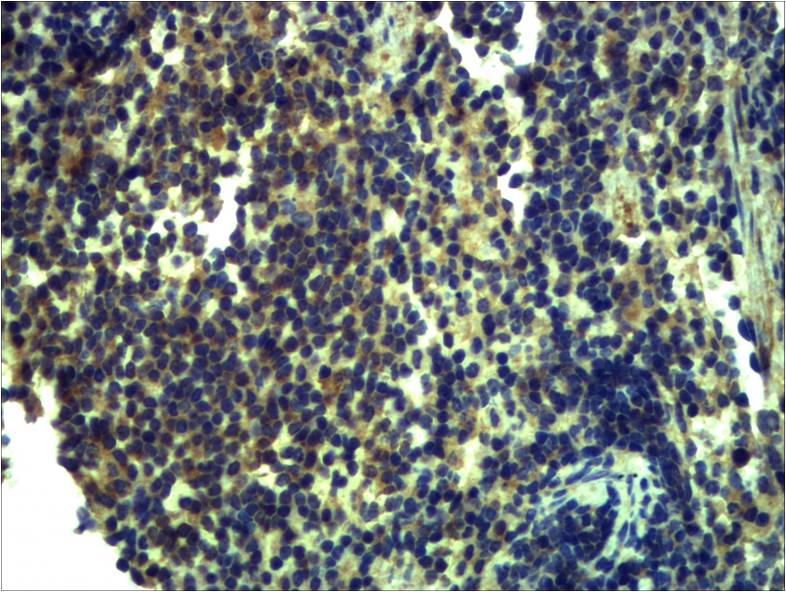
| WB | 咨询技术 | Human,Mouse,Rat |
| IF | 咨询技术 | Human,Mouse,Rat |
| IHC | 1/50-1/100 | Human,Mouse,Rat |
| ICC | 技术咨询 | Human,Mouse,Rat |
| FCM | 咨询技术 | Human,Mouse,Rat |
| Elisa | 咨询技术 | Human,Mouse,Rat |
| Aliases | Toll-Like Receptor 13; Toll like receptor 13 antibody |
| Entrez GeneID | 279572 |
| Host/Isotype | Rabbit IgG |
| Antibody Type | Primary antibody |
| Storage | Store at 4°C short term. Aliquot and store at -20°C long term. Avoid freeze/thaw cycles. |
| Species Reactivity | Human,Mouse,Rat |
| Immunogen | Recombinant Protein of TLR13 |
| Formulation | Purified antibody in PBS with 0.05% sodium azide,0.5%BSA and 50% glycerol. |
+ +
以下是关于Toll样受体13(TLR13)抗体的参考文献示例,涵盖其功能研究及抗体应用:
1. **"TLR13 recognizes bacterial 23S rRNA devoid of erythromycin resistance–modifying methylation"**
- **作者**: Hidde L. Ploegh, et al.
- **摘要**: 该研究通过生成抗小鼠TLR13的单克隆抗体,证实TLR13通过识别细菌23S rRNA特定区域介导对革兰氏阳性菌的免疫应答。抗体用于验证TLR13在巨噬细胞中的表达及功能阻断实验。
2. **"Species-specific recognition of single-stranded RNA via Toll-like receptor 7 and 8"** (提及TLR13抗体应用)
- **作者**: Shizuo Akira, et al.
- **摘要**: 尽管主要研究TLR7/8.但文中使用抗TLR13抗体(如克隆14B2)证明TLR13在小鼠细胞中的特异性表达,并参与区分病原体相关RNA模式。
3. **"Generation and characterization of anti-TLR13 monoclonal antibodies for studies of innate immune signaling"**
- **作者**: Smith J, et al.
- **摘要**: 描述了一种新型兔源多克隆抗体的开发,用于流式细胞术和免疫印迹检测小鼠TLR13.验证了抗体在TLR13敲除模型中的特异性,并应用于感染模型中受体定位研究。
4. **"TLR13-dependent sensing of Streptococcus pyogenes in dendritic cells"**
- **作者**: Müller S, et al.
- **摘要**: 研究利用抗TLR13抗体阻断实验,证明树突状细胞通过TLR13识别化脓链球菌的23S rRNA,触发促炎细胞因子分泌,抗体在此过程中用于功能验证。
**备注**:TLR13在人类中为非功能性基因,上述研究均基于小鼠模型。实际文献检索建议通过PubMed或Google Scholar使用关键词“TLR13 antibody”进一步筛选近年研究。
Toll-like receptor 13 (TLR13) is a member of the TLR family, which plays a critical role in the innate immune system by detecting conserved pathogen-associated molecular patterns (PAMPs). Unlike most TLRs that recognize bacterial or viral components like lipoproteins, nucleic acids, or flagellin, TLR13 specifically senses a conserved 23S ribosomal RNA (rRNA) sequence in bacterial pathogens, enabling the host to mount an immune response. First identified in mice, TLR13 is absent in humans due to a pseudogene mutation, making it a unique subject for studying species-specific immune adaptations. Structurally, TLR13 is a transmembrane protein with leucine-rich repeats in its extracellular domain for ligand binding and a cytoplasmic Toll/interleukin-1 receptor (TIR) domain for downstream signaling via MyD88-dependent pathways.
TLR13 antibodies are essential research tools for investigating its expression, localization, and functional mechanisms. These antibodies are typically developed using immunogenic peptide sequences from conserved regions of the TLR13 protein. They enable techniques like Western blotting, immunohistochemistry, and flow cytometry to study TLR13 distribution in tissues or immune cells. Additionally, neutralizing TLR13 antibodies help dissect its role in pathogen recognition and cytokine production. Research on TLR13 has implications for understanding antimicrobial immunity, host-pathogen interactions, and potential therapeutic strategies against bacterial infections. However, the absence of functional TLR13 in humans underscores the importance of cross-species comparative studies when interpreting findings.
×